More From the Los Angeles Times
-
-
Nov. 14, 2024
-
-
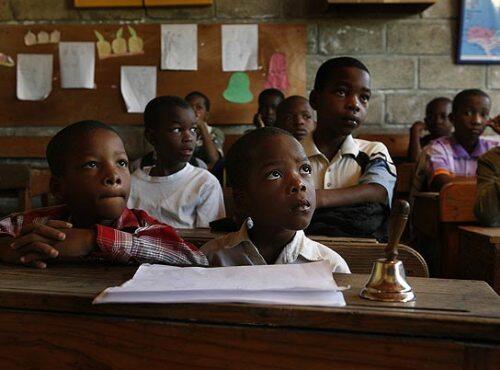
Etienne Louis, 7, left, and his brother Samuel, 5, try to listen to their teacher despite an argument in the courtyard of Plein Soleil school in Port-au-Prince, Haiti. (Carolyn Cole / Los Angeles Times)
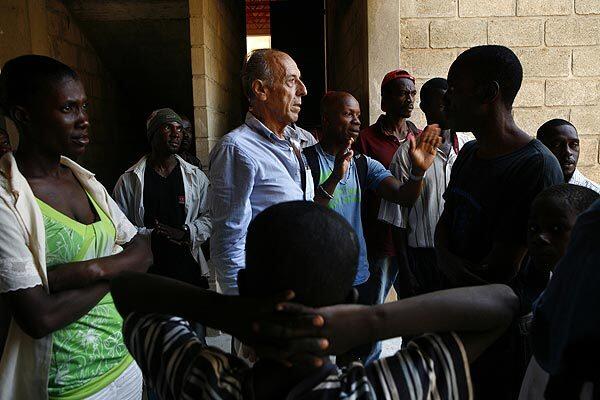
At the Plein Soleil elementary school, which provides education for impoverished boys, director Michel Vaillaud tells Haitians left homeless by the Jan. 12 earthquake that they must leave the grounds. An argument ensued. (Carolyn Cole / Los Angeles Times)
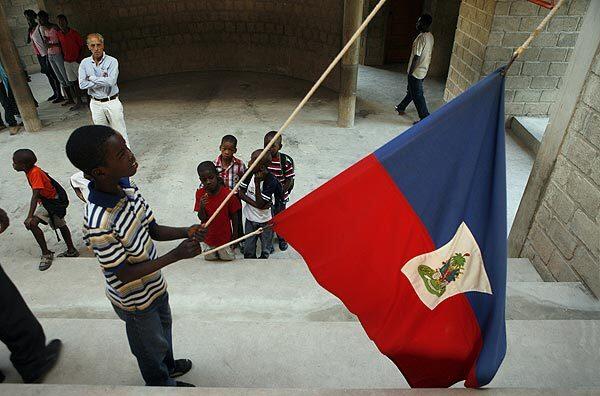
A student raises the Haitian flag on the boys’ first day back at school since the quake. In the background is Michel Vaillaud, who, with his wife, Francoise, founded the school. (Carolyn Cole / Los Angeles Times)
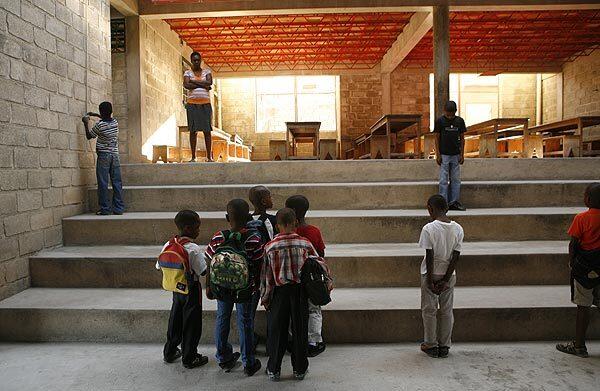
Only two dozen of the 200 students enrolled at the school were there for the reopening. The building was designed by two Haitian architects who relied on internationally accepted building codes, and it rode out the earthquake with only a few hairline cracks in its concrete floor. (Carolyn Cole / Los Angeles Times)
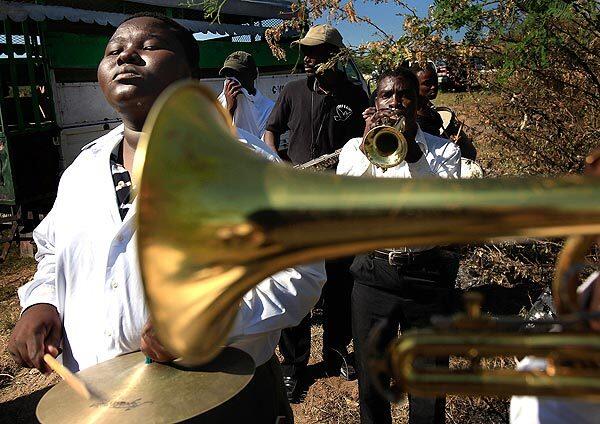
A small brass band plays while the dead are buried in a mass grave in Titanyen, outside Port-au-Prince, Haiti. (Brian Vander Brug / Los Angeles Times)
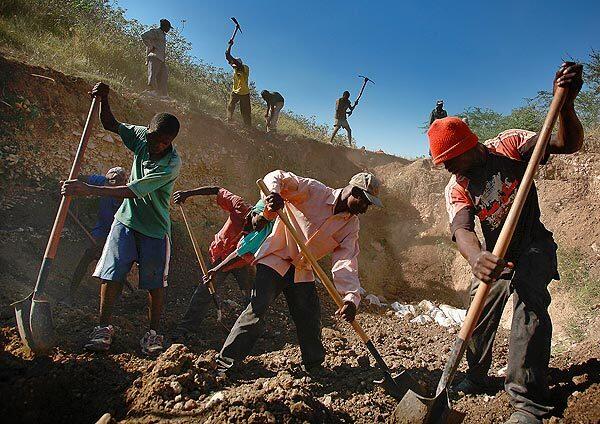
Men cover the dead with dirt and rocks. (Brian Vander Brug / Los Angeles Times)
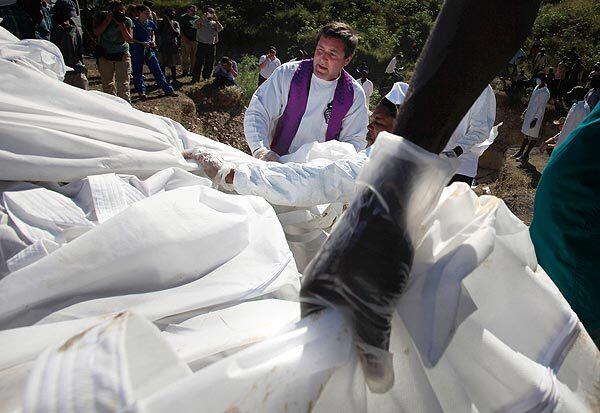
Father Rick Frechette helps lift body bags off a truck for burial. (Brian Vander Brug / Los Angeles Times)
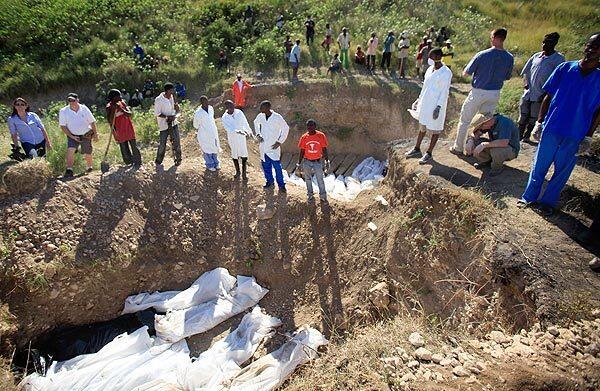
Bodies are laid out in the graves. (Brian Vander Brug / Los Angeles Times)
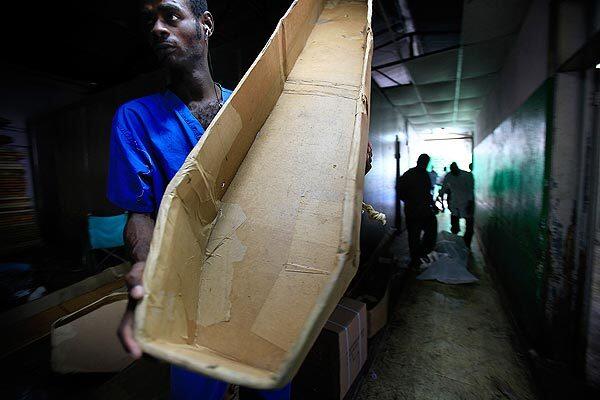
A morgue worker at a hospital in Port-au-Prince carries a cardboard coffin prepared for one of hundreds of dead being transferred for mass burial in Titanyen. (Brian Vander Brug / Los Angeles Times)
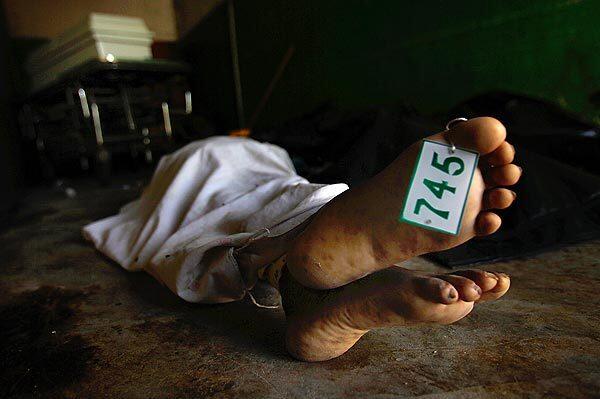
Bodies are tagged before transfer to mass graves. (Brian Vander Brug / Los Angeles Times)
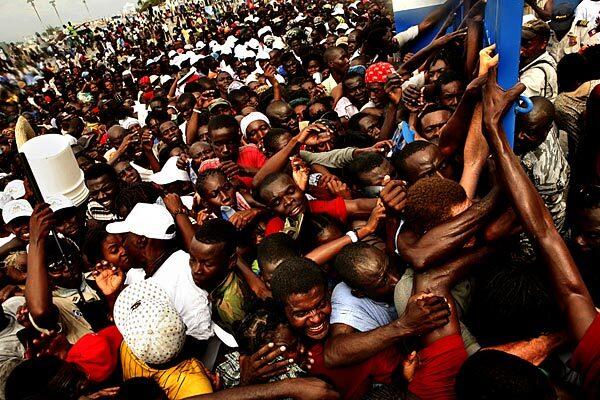
A crowd gathered for food distribution gets out of control despite a heavy police presence in Cite Soleil, one of the poorest neighborhoods in Port-au-Prince. Thousands gathered at a gate trying to get food. (Carolyn Cole / Los Angeles Times)
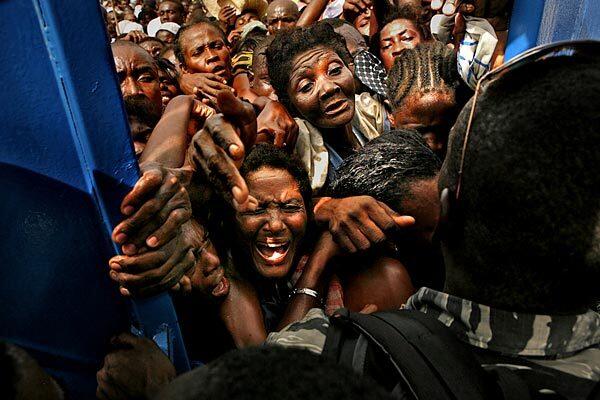
Desperate Haitians try to push through a gate at a food handout in the poor Port-au-Prince neighborhood of Cite Soleil. Some women collapsed from exhaustion in the crush of people trying to get food. (Carolyn Cole / Los Angeles Times)
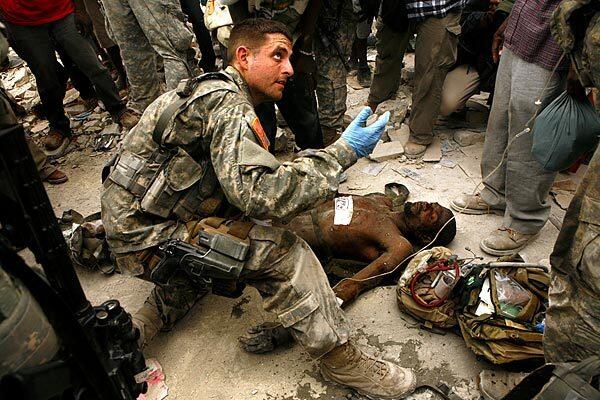
U.S. Army Spc. Nelson Whitney of the 82nd Airborne Division assists a severely dehydrated man who was pulled out of the rubble of a collapsed building in downtown Port-au-Prince. It is unknown whether he had been trapped for two weeks since the original earthquake. (Carolyn Cole / Los Angeles Times)
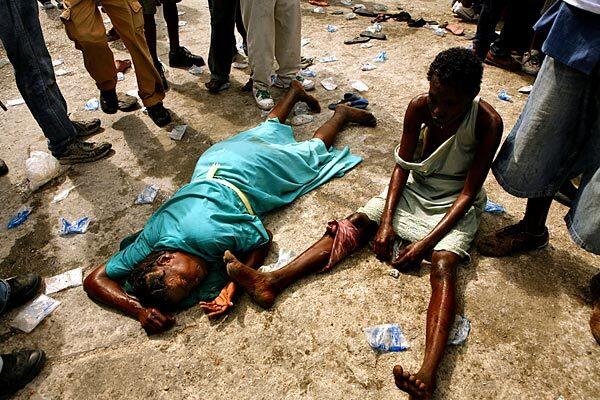
Two women collapse from exhaustion after fighting the line to reach a food handout. Despite a heavy police presence in Cite Soleil, one of the poorest neighborhoods in Port-au-Prince, the food distribution became violent. Thousands crowded at a gate trying to get food. (Carolyn Cole / Los Angeles Times)
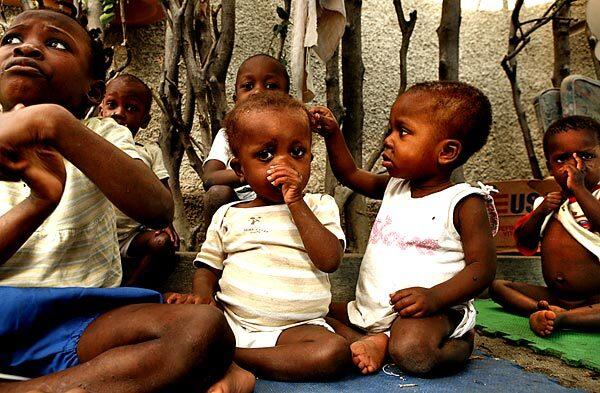
These children at Horizon of Hope in Port-au-Prince have been at the private center, which functions as an adoption agency, since before the earthquake. (Carolyn Cole / Los Angeles Times)
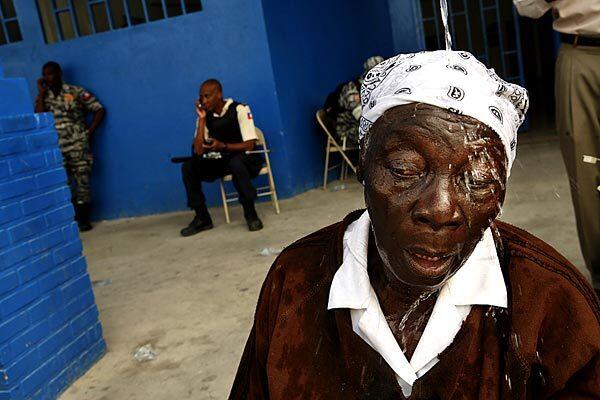
Water is poured over the head of an elderly woman who collapsed while trying to make her way through a crowd to reach a food handout in the Cite Soleil neighborhood in Port-au-Prince. (Carolyn Cole / Los Angeles Times)
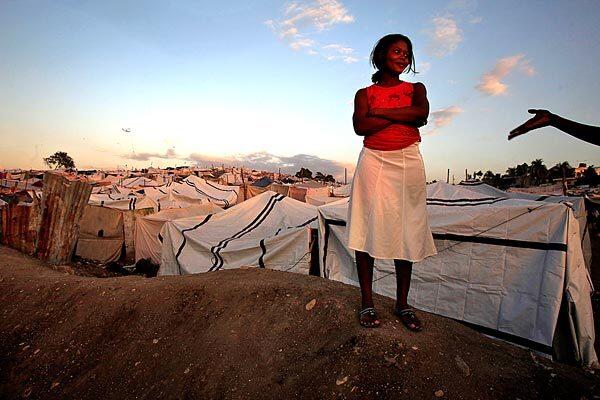
A Haitian woman eyes a man flirting with her as life goes on in a tent camp on the outskirts of Port-au-Prince. (Brian Vander Brug / Los Angeles Times)
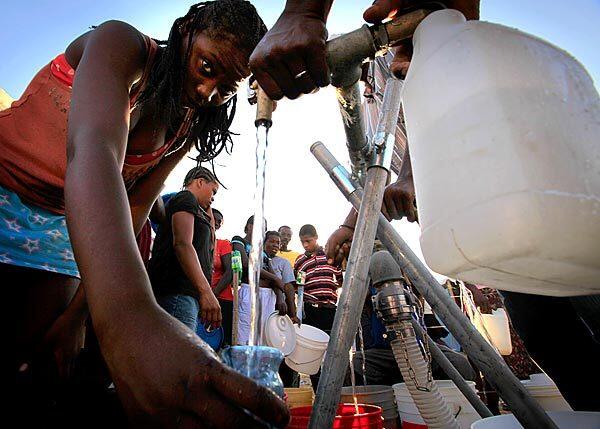
Displaced Haitians line up for water in the Port-au-Prince tent camp where they now live. (Brian Vander Brug / Los Angeles Times)
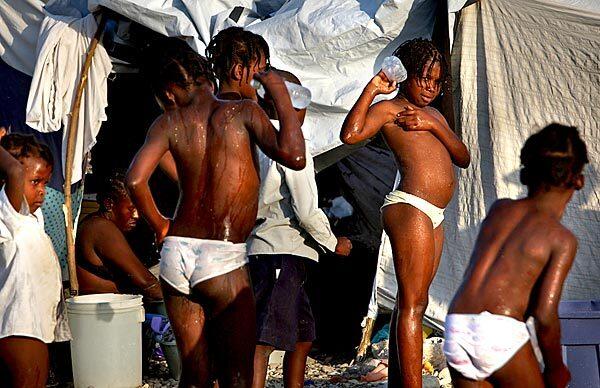
Girls bathe in the tent camp, where residents make do without amenities such as electricity and running water. (Brian Vander Brug / Los Angeles Times)
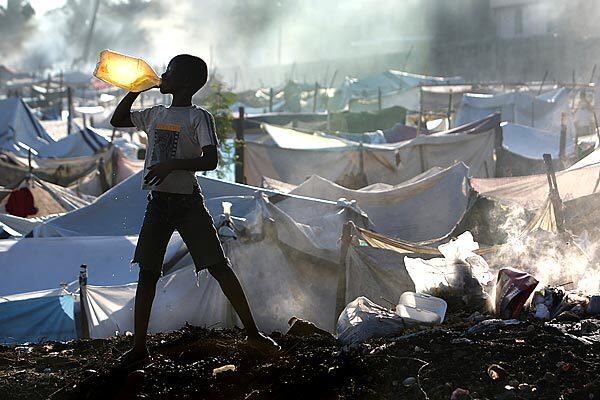
Rudeson Laurent, 10, takes a drink of water after brushing his teeth on a smoldering pile of trash. (Brian Vander Brug / Los Angeles Times)
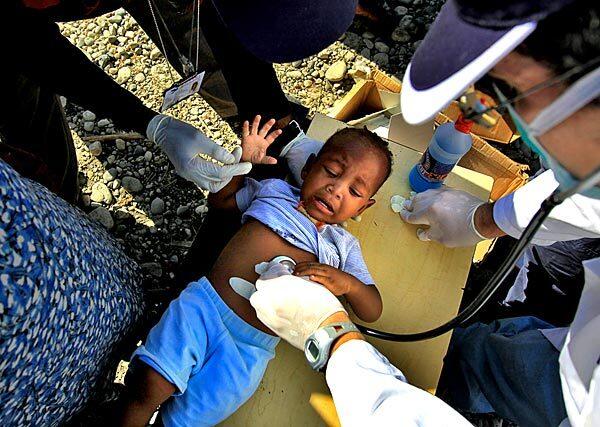
A boy is checked by doctors from the Dominican Republic at a makeshift clinic in camp. (Brian Vander Brug / Los Angeles Times)
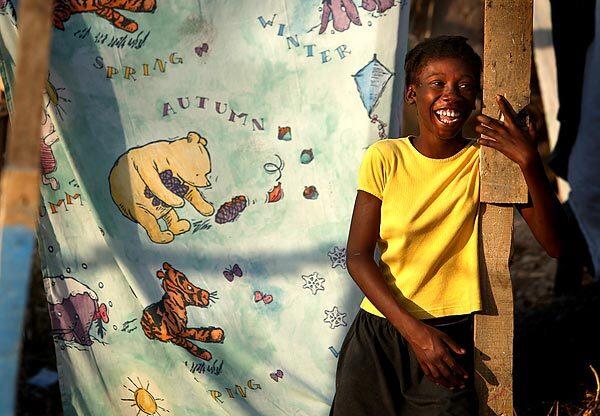
A young Haitian woman in the tent camp still finds a reason to smile. (Brian Vander Brug / Los Angeles Times)
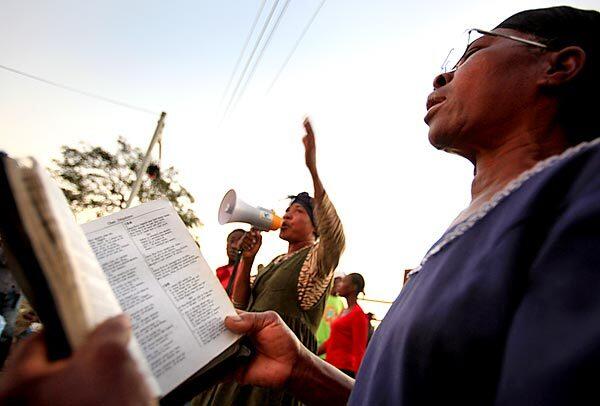
Street preachers extol the power of God to residents of the tent camp. (Brian Vander Brug / Los Angeles Times)
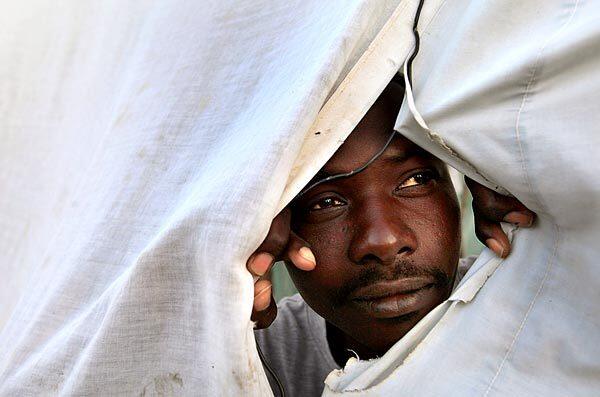
Jendy Duval, 33, peers out of his tent. (Brian Vander Brug / Los Angeles Times)
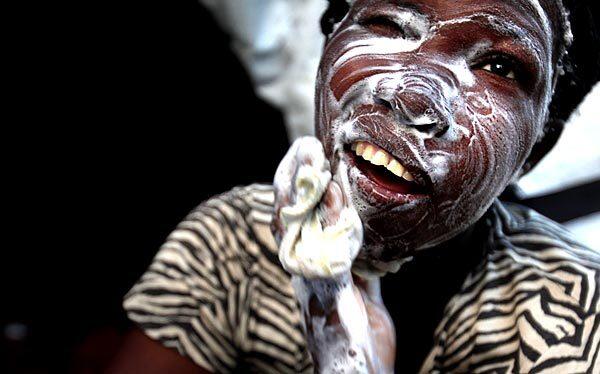
Angela Paul washes up in her tent. (Brian Vander Brug / Los Angeles Times)
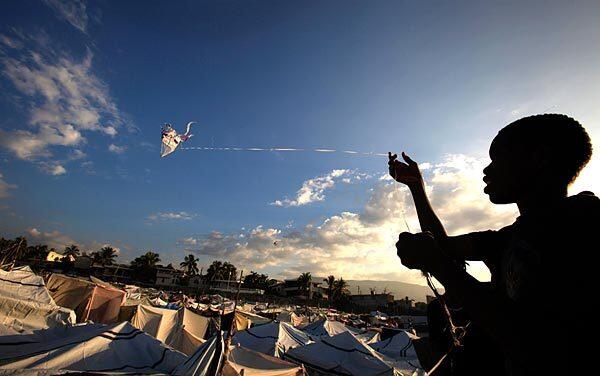
A Haitian boy flies a kite over the tent camp that has become his home. (Brian Vander Brug / Los Angeles Times)
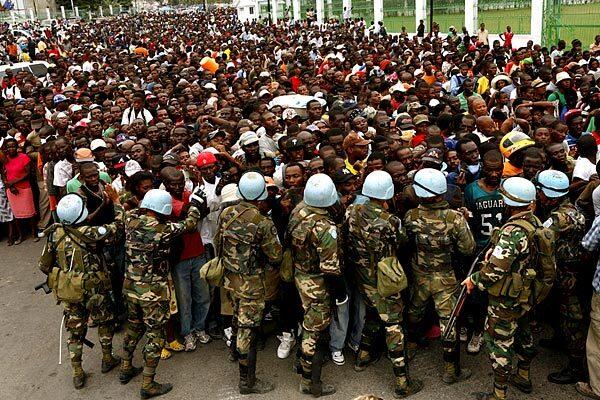
United Nations troops from Uruguay try to control the crowd of thousands so that sacks of rice from the U.S. can be distributed in the capital, Port-au-Prince. (Carolyn Cole / Los Angeles Times)
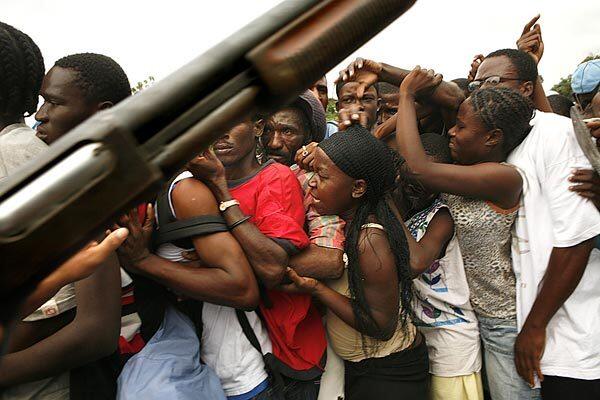
The distribution of rice got out of control as thousands of people surged forward. United Nations troops fired tear gas to try to control the crowd in Port-au-Prince. (Carolyn Cole / Los Angeles Times)
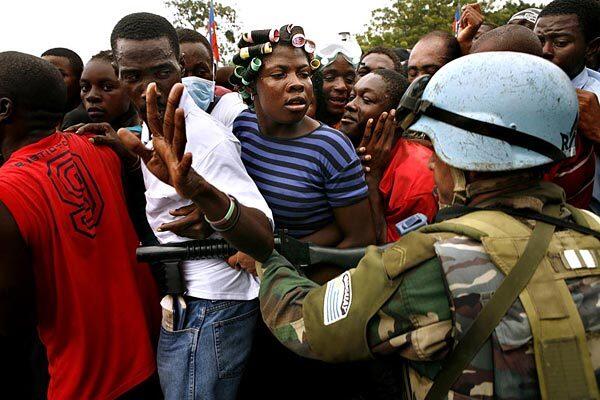
A U.N. soldier uses his weapon, which fires tear gas, to push back people scrambling for sacks of rice at a distribution point in Port-au-Prince. (Carolyn Cole / Los Angeles Times)
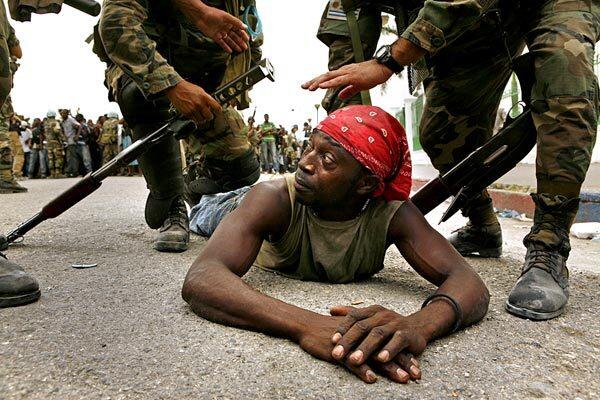
A man is detained by U.N. soldiers. Many architects and planners envision a new capital with fewer people and more oversight. (Carolyn Cole / Los Angeles Times)
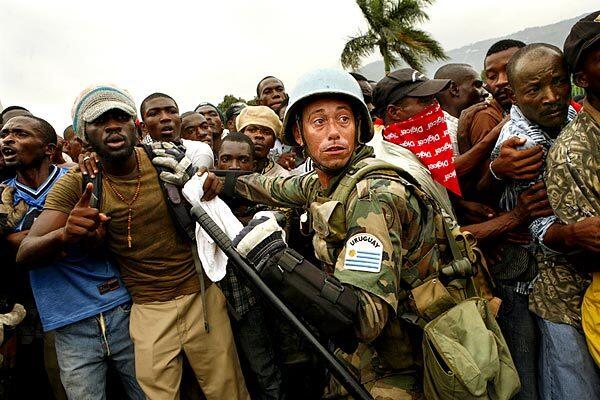
A U.N. soldier from Uruguay tries to hold back a surging crowd at a food distribution point in Port-au-Prince. Thousands waited for rice, but supplies ran out. (Carolyn Cole / Los Angeles Times)
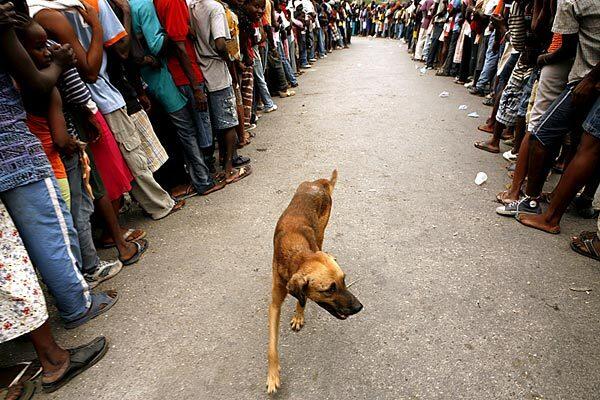
A hungry dog gets fenced in by a food distribution line in Port-au-Prince. Thousands of Haitians hoped to get bags of American rice distributed by the World Food Program, but in the end, supplies ran short. (Carolyn Cole / Los Angeles Times)
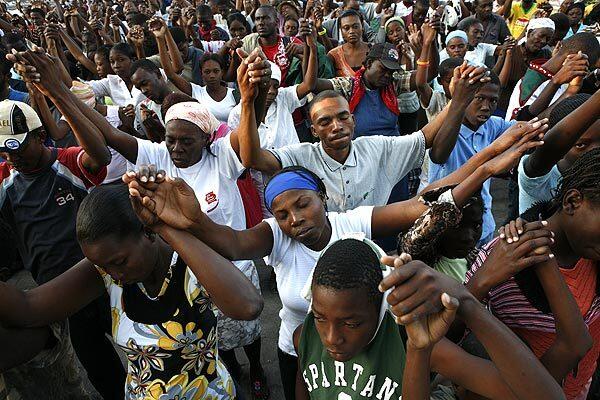
Christian Haitians assemble in the center of Port-au-Prince, the capital, as part of a three-day prayer gathering. (Carolyn Cole / Los Angeles Times)
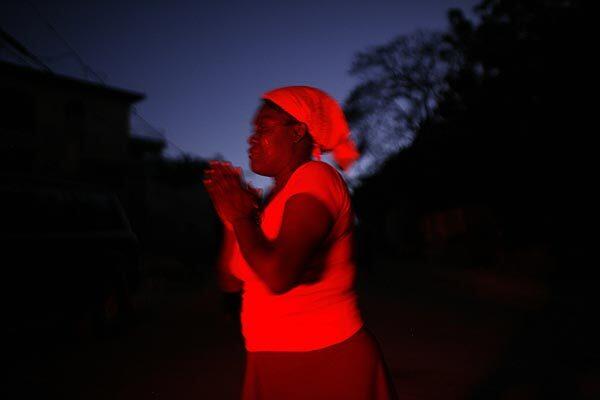
A woman prays at the break of dawn in Port-au-Prince. At night, rich and poor take to the streets to sleep, worried about being caught in their homes if aftershocks hit. (Carolyn Cole / Los Angeles Times)
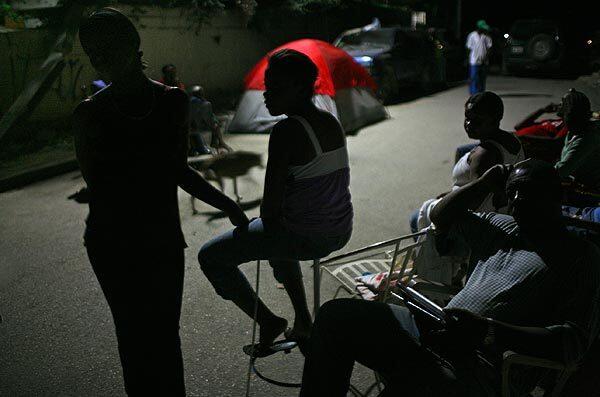
In the Delmas area, three families with more than 75 members among them camp out on Rue Daine. They share their food and chat before turning in. (Carolyn Cole / Los Angeles Times)
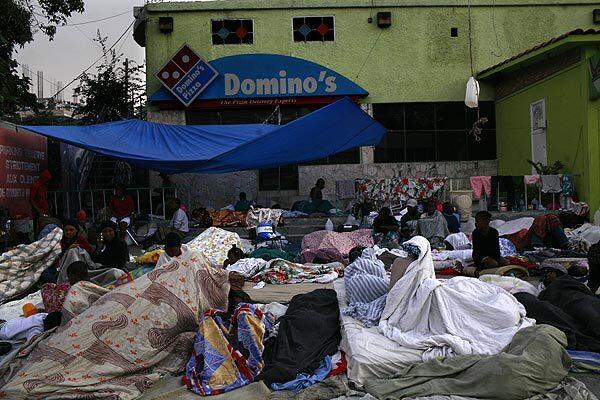
Many Haitians in Port-au-Prince are sleeping outdoors nearly two weeks after the earthquake. They are either homeless or too afraid to go back into their houses. In Petionville, a pizza restaurant serves as a huge sleeping area. (Carolyn Cole / Los Angeles Times)
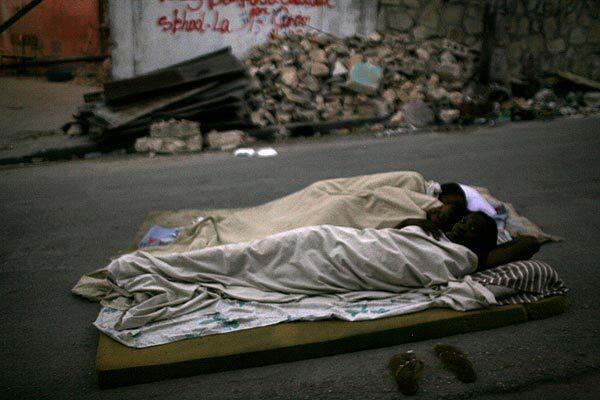
Haitians in one Port-au-Prince neighborhood catch some sleep outdoors, too afraid to go back into their homes. (Carolyn Cole / Los Angeles Times)
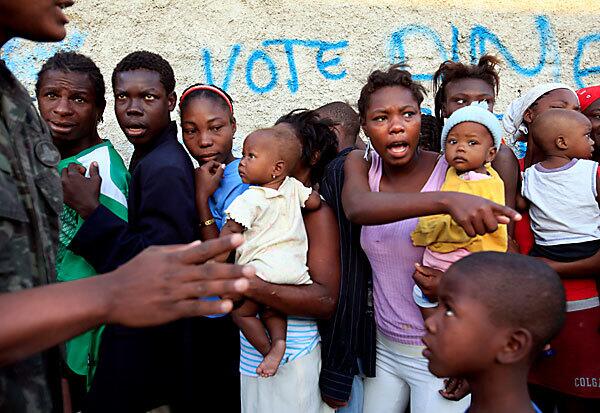
Residents of Cite Soleil, a district in Port-au-Prince and one of the poorest slums in the Americas, line up for aid and get instructions from troops. (Brian Vander Brug / Los Angeles Times)
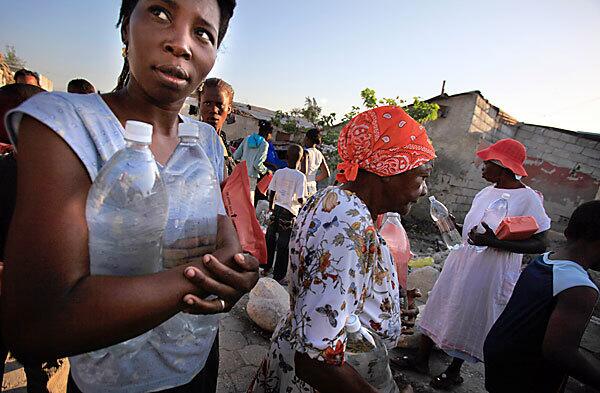
Residents of Cite Soleil leave with food supplies delivered by the U.S. military’s 82nd Airborne and UN.. soldiers from Brazil. (Brian Vander Brug / Los Angeles Times)
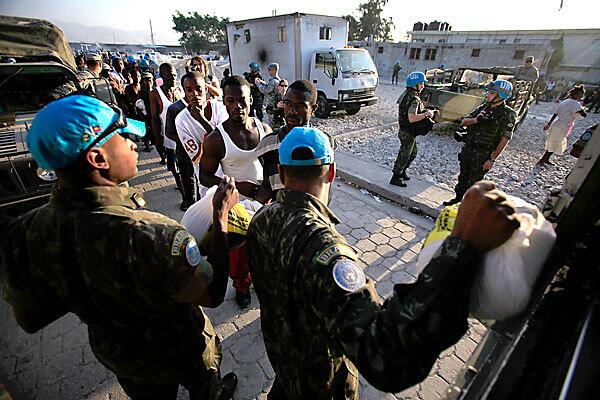
United Nations soldiers from Brazil pass out food from a truck to residents of Cite Soleil, an impoverished neighborhood of Port-au-Prince. (Brian Vander Brug / Los Angeles Times)
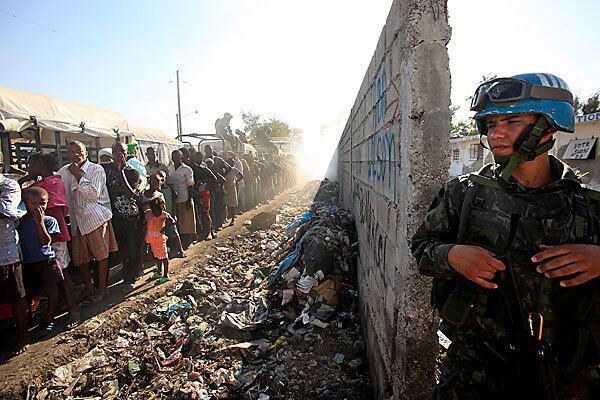
Residents of Cite Soleil line up for aid next to an open sewer filled with trash, some of it smoldering, as a U.N. peacekeeper from Brazil stands watch. (Brian Vander Brug / Los Angeles Times)
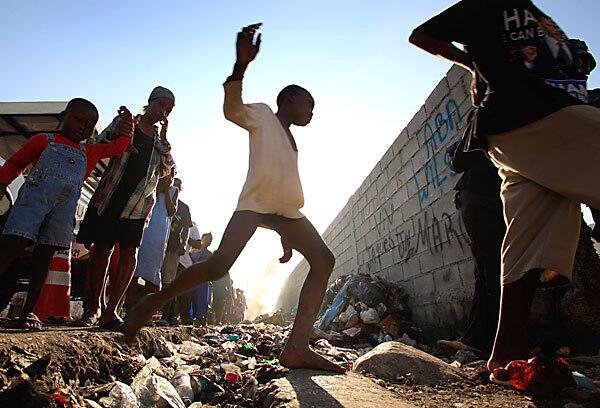
Residents of Cite Soleil jump over an open sewer with smoldering trash to get to a food distribution point. (Brian Vander Brug / Los Angeles Times)
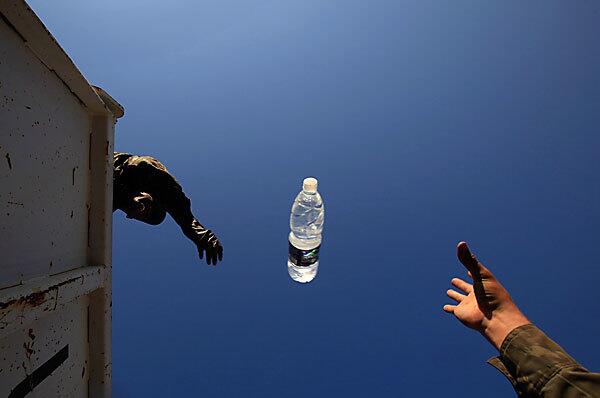
U.N. troops from Brazil toss water bottles out of a large truck in an alley in Cite Soleil. (Brian Vander Brug / Los Angeles Times)
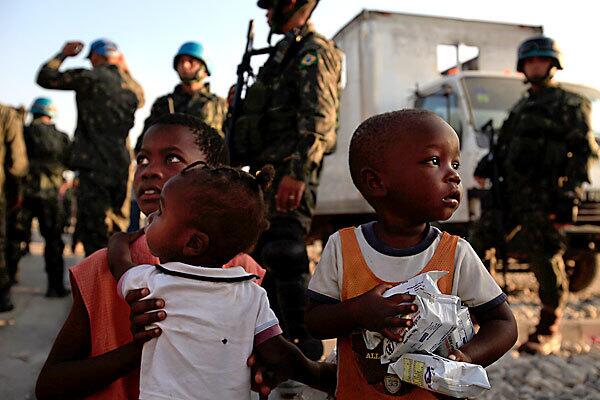
Children in Cite Soleil look for their mother after getting emergency food rations. (Brian Vander Brug / Los Angeles Times)
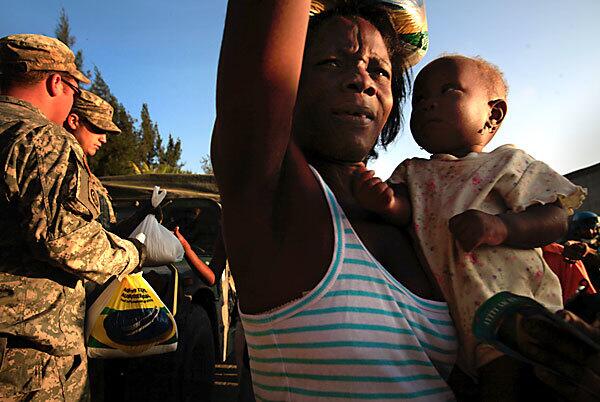
Residents of Cite Soleil leave with food aid, delivered by the United States’ 82nd Airborne and U.N. soldiers from Brazil. (Brian Vander Brug / Los Angeles Times)
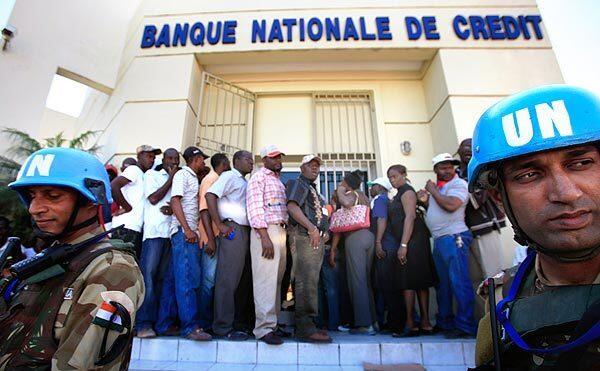
United Nations troops keep guard at a newly-opened bank in Petionville, a suburb of Port-au-Prince. It was the first day since the quake that customers were allowed in to withdraw money and make transactions. (Brian Vander Brug / Los Angeles Times)
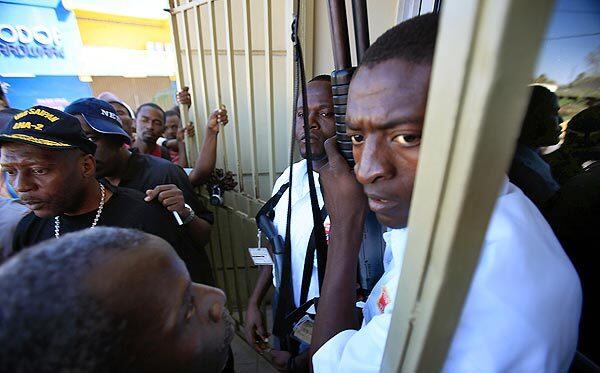
Security officers with shotguns stand guard at the front doors of a bank in Petionville as customers queued up to get access to their accounts, the first time since the quake. (Brian Vander Brug / Los Angeles Times)
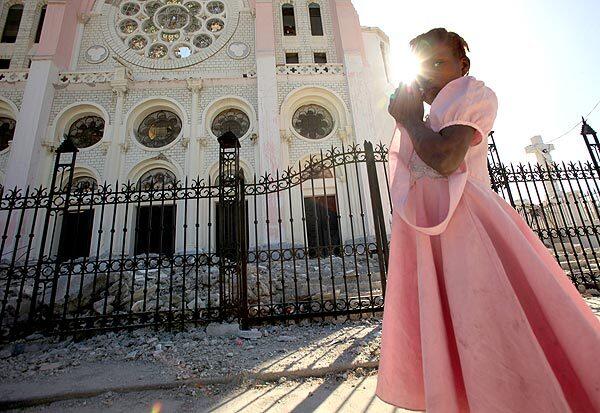
A young girl is dressed in her best available clothes to attend the funeral Mass for Roman Catholic Archbishop Joseph Serge Miot, 63, and Charles Benoit, the general vicar of the church, at the ruins of the Notre Dame Cathedral in Port-au-Prince. (Brian Vander Brug / Los Angeles Times)
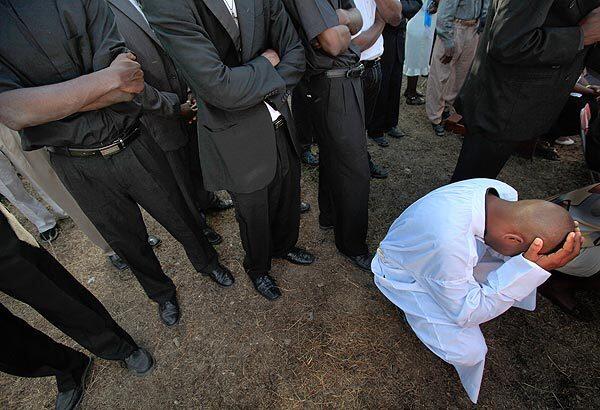
A priest in a white robe crouches in grief at the funeral Mass for Archbishop Joseph Serge Miot at the Notre Dame Cathedral in in Port-au-Prince. “This is very hard to explain,” said Father Giroux Mirine, a Canadian priest who has lived and worked in Haiti for 19 years. “We cannot blame God. We have to confront nature.” (Brian Vander Brug / Los Angeles Times)
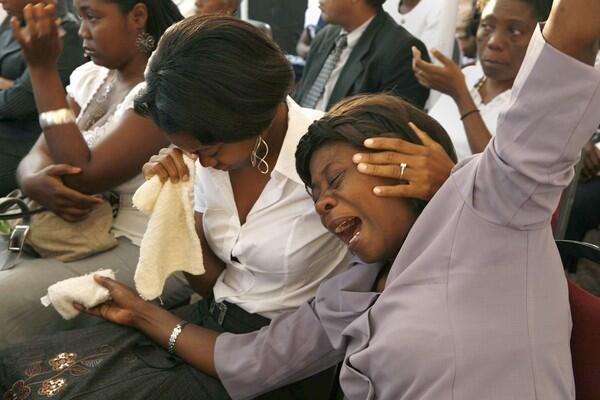
Women mourn the loss of Haiti’s Archbishop Joseph Serge Miot and General Vicar Charles Benoit at the funeral in Port-au-Prince. (Carolyn Cole / Los Angeles Times)
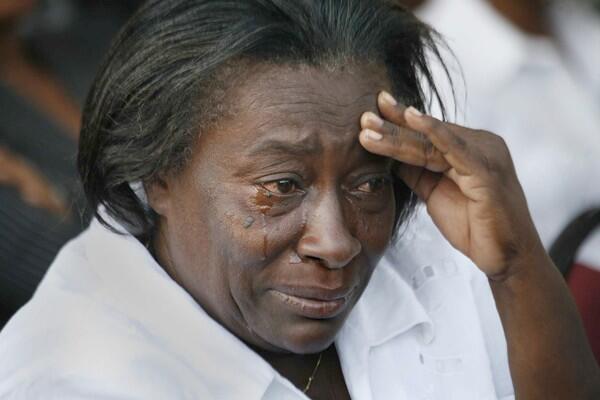
A woman mourns the deaths of Haiti’s Archbishop Joseph Serge Miot and General Vicar Charles Benoit during the funeral in Port-au-Prince. (Carolyn Cole / Los Angeles Times)
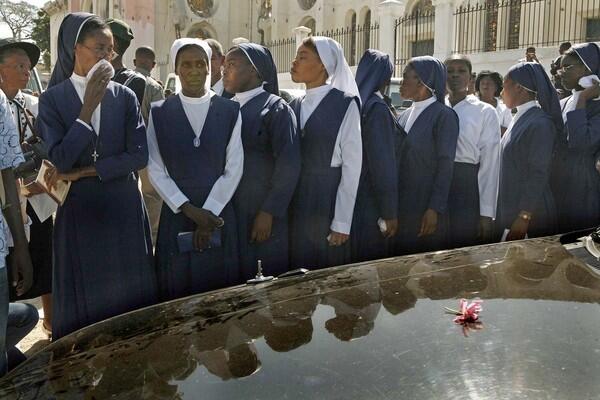
Nuns stand beside a hearse during the funeral of Archbishop Joseph Serge Miot and General Vicar Charles Benoit in front of Port-au-Prince’s Notre Dame Cathedral, which was destroyed in the Jan. 12
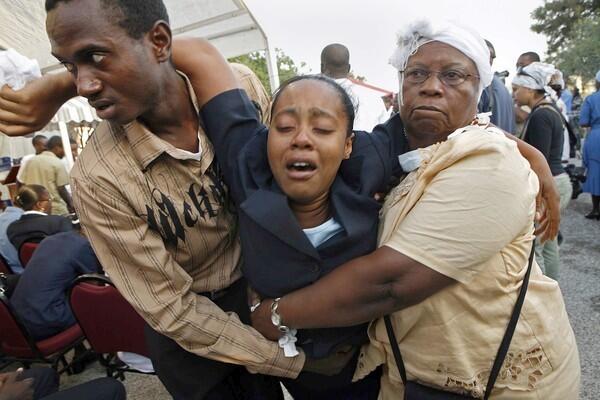
A woman overcome by emotion is helped away during the funeral for Archbishop Joseph Serge Miot and General Vicar Charles Benoit in front of the destroyed Notre Dame Cathedral in Port-au-Prince. (Carolyn Cole / Los Angeles Times)
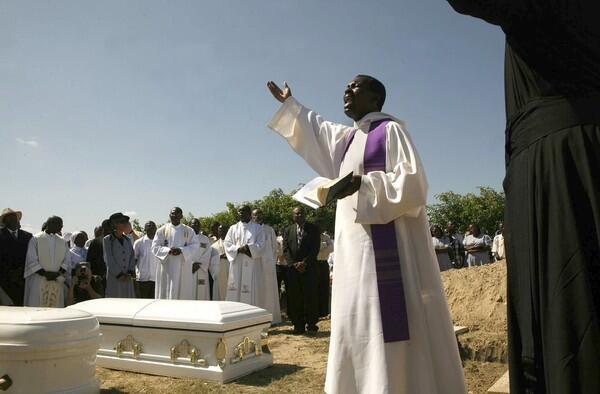
A burial service is held for Haitian Archbishop Joseph Serge Miot and General Vicar Charles Benoit in Port-au-Prince. (Carolyn Cole / Los Angeles Times)
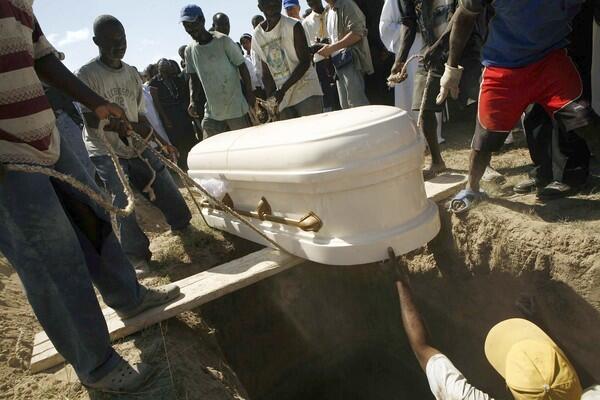
A casket is lowered after the funeral for Archbishop Joseph Serge Miot and Charles Benoit, the church’s general vicar. Hundreds of priests and parishioners attended the service at Notre Dame Cathedral in Port-au-Prince. (Carolyn Cole / Los Angeles Times)
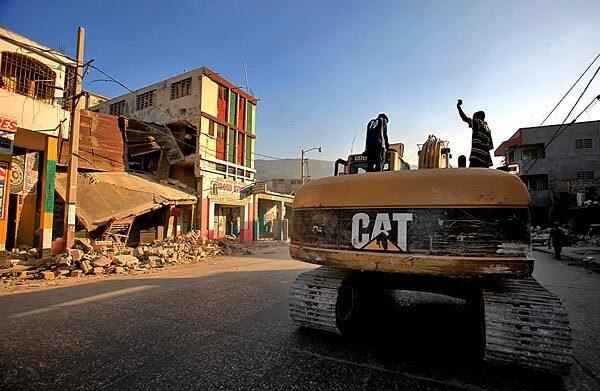
A man riding on a backhoe in downtown Port-au-Prince waves. Heavy equipment is being moved into downtown as cleanup begins sporadically in the quake-ravaged city. (Brian Vander Brug / Los Angeles Times)
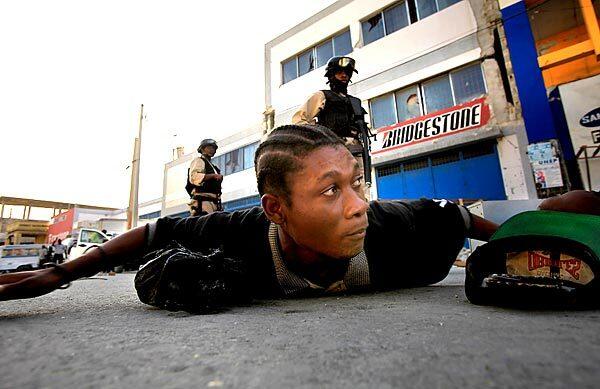
Police detain a man suspected of looting in downtown Port-au-Prince. The man, who refused to be identified, was later released. (Brian Vander Brug / Los Angeles Times)
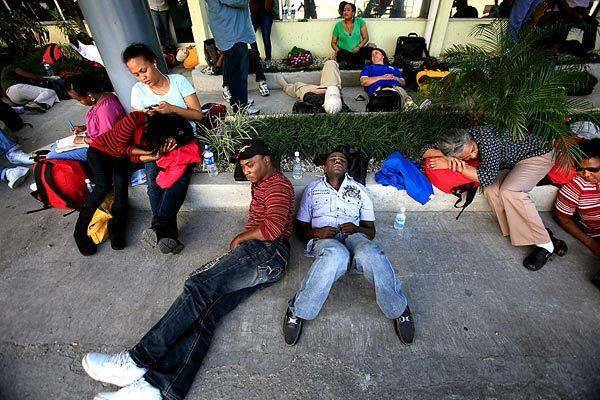
People, many of them aid workers trying to get home, wait in the shade for flights out at the airport in Port-au-Prince. (Brian Vander Brug / Los Angeles Times)
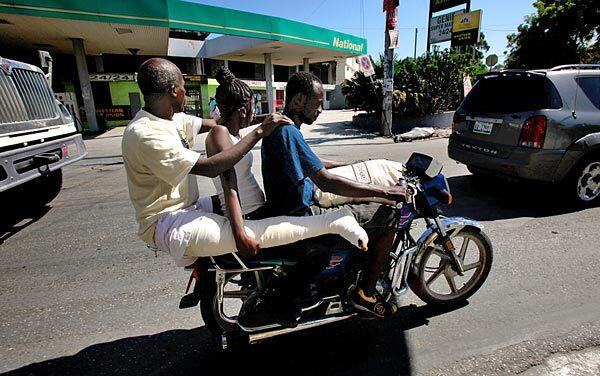
Three people including a man with a full leg cast, ride through Port-au-Prince. (Brian Vander Brug / Los Angeles Times)
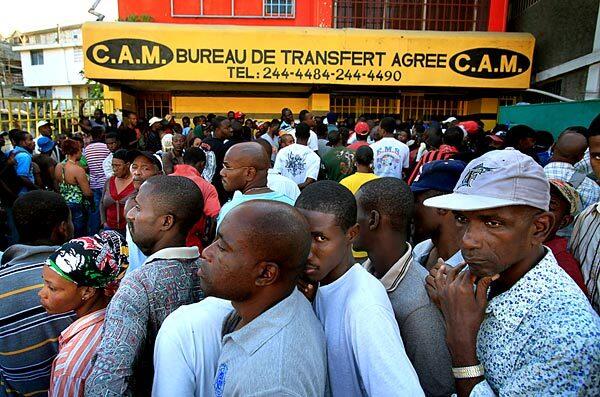
Hundreds of Haitians line up at a money transfer store to collect remittances from family abroad. The city’s banks will open for the first time Jan. 23 since the 7.0 quake hit last week. (Brian Vander Brug / Los Angeles Times)
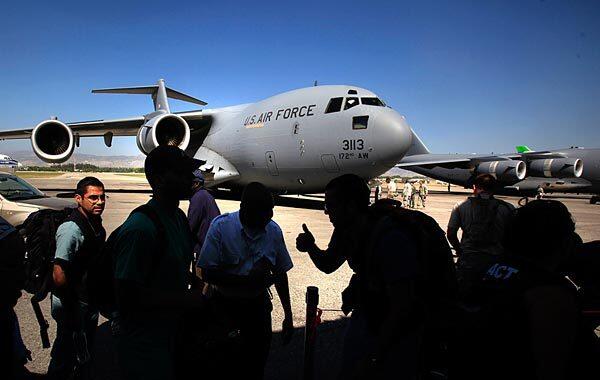
People line up on the tarmac for a flight out at the airport in Port-au-Prince. (Brian Vander Brug / Los Angeles Times)

Aircraft, both civilian and military, from countries all over the world continue to bring in aid to the airport in Port-au-Prince. Three other airfields also are being used, two nearby and one in the Dominican Republic. (Brian Vander Brug / Los Angeles Times)
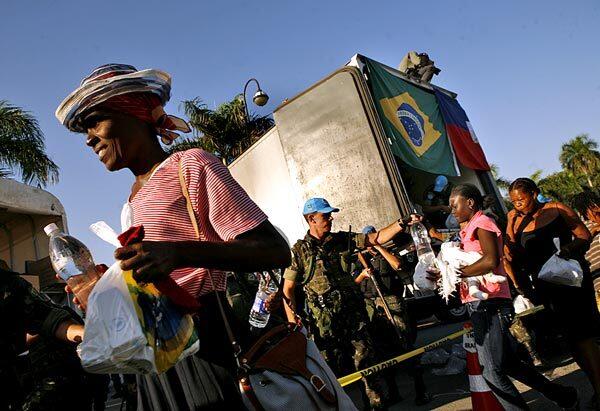
Haitians line up in front of the presidential palace in Port-au-Prince for handouts of food and water from Brazilian troops with the United Nations. (Carolyn Cole / Los Angeles Times)
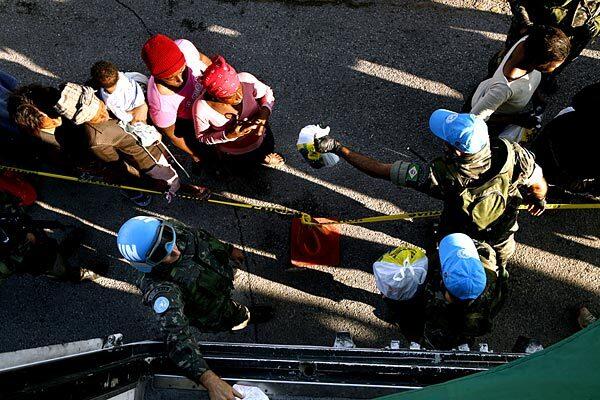
People queue for food and water handouts from Brazilian troops serving with the United Nations. (Carolyn Cole / Los Angeles Times)
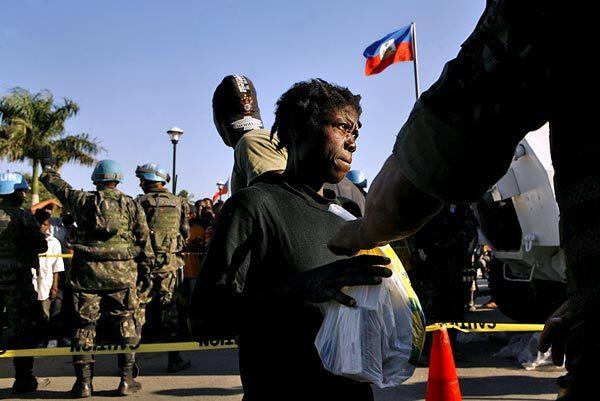
A woman gets a supply of food and water from Brazilian troops with the United Nations. The U.N.’s World Food Program said it had distributed 1.5 million rations, mostly high-energy biscuits. (Carolyn Cole / Los Angeles Times)
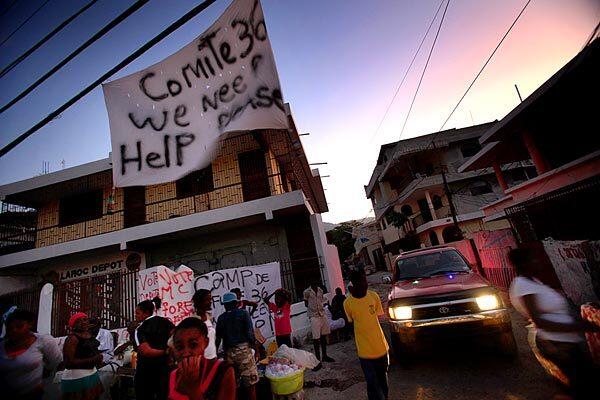
A banner calling for help in the Delmas 36 neighborhood in Port-au-Prince. U.S. officials said they are using three additional airfields to speed the arrival of supplies. (Brian Vander Brug / Los Angeles Times)
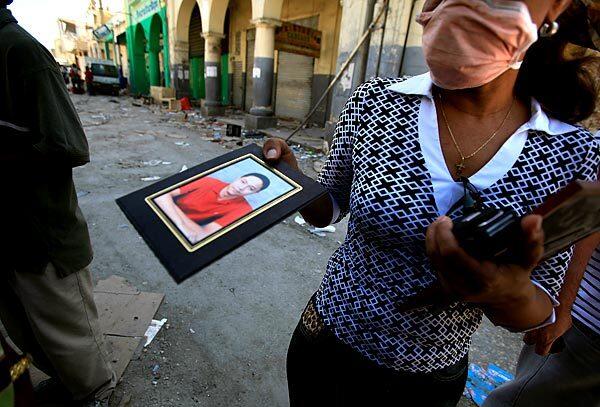
Rose Marie Riviera offers a portrait of her son Robert to a friend in downtown Port-au-Prince where she and her husband returned to their hardware store to assess damage. Robert, 18, was killed last week when the magnitude 7.0 quake struck. (Brian Vander Brug / Los Angeles Times)
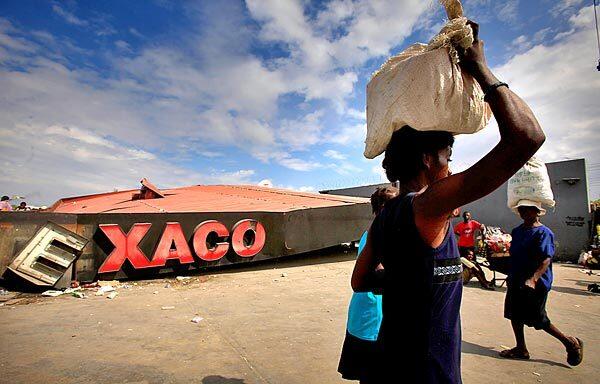
Women carry supplies past a collapsed Texaco gas station in Port-au-Prince. Gasoline supplies may become a problem as a pier servicing tankers was damaged in the earthquake. (Brian Vander Brug / Los Angeles Times)
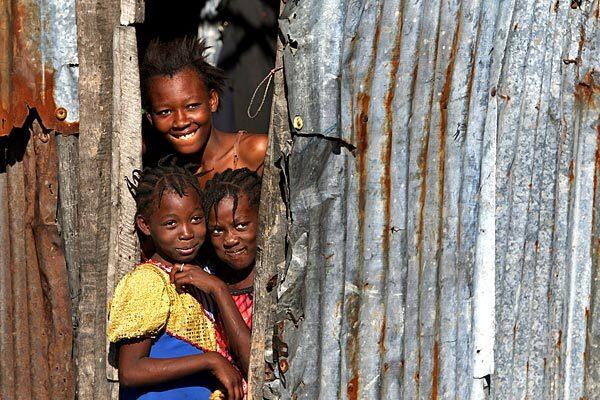
Young girls peer out of their corrugated steel home on the wharf in Port-au-Prince. U.S. military officials said the seaport is being reopened partially and will be able to handle up to 250 containers. (Brian Vander Brug / Los Angeles Times)
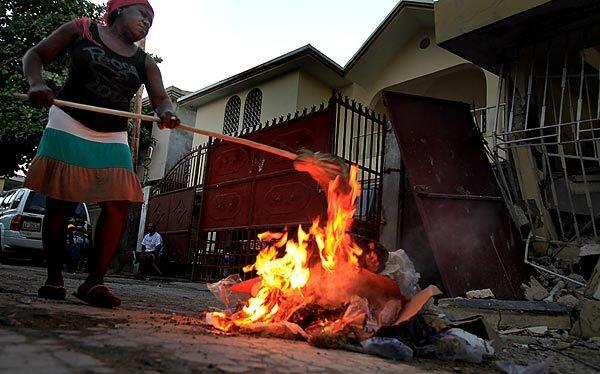
Jocelyne Arther sweeps trash into a bonfire in an alley, where she lives with her family since moving out of her quake-damaged home in Delmas 36. Residents of the neighborhood are organizing to get food, water and tents because most are living on the streets, afraid or unable to move back into their damaged homes. (Brian Vander Brug / Los Angeles Times)
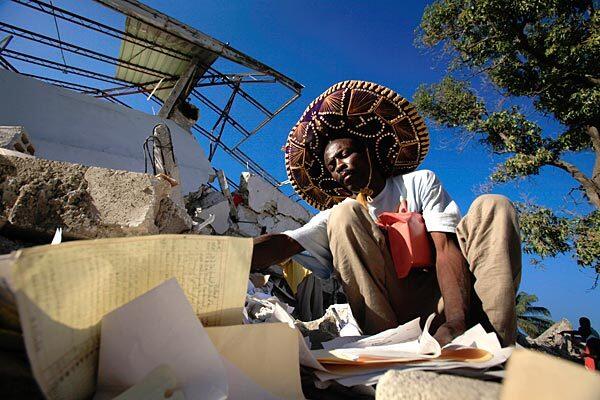
A man wears a sombrero he found at the Foreign Ministry office in Port-au-Prince. The man, who declined to be identified, said he was a custodian at the building and was gathering documents for sorting. (Brian Vander Brug / Los Angeles Times)
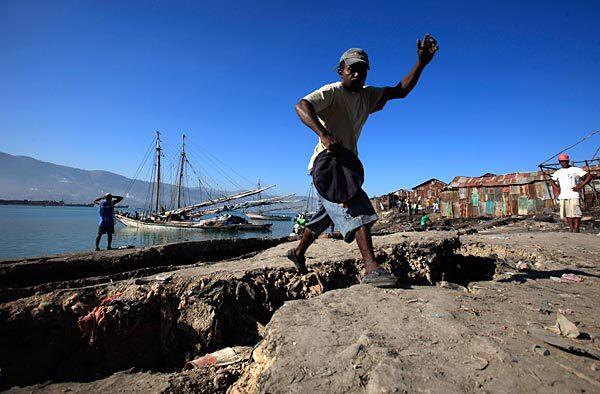
A man jumps over a crack in the ground along the wharf in Port-au-Prince. There are many large cracks in the area. (Brian Vander Brug / Los Angeles Times)
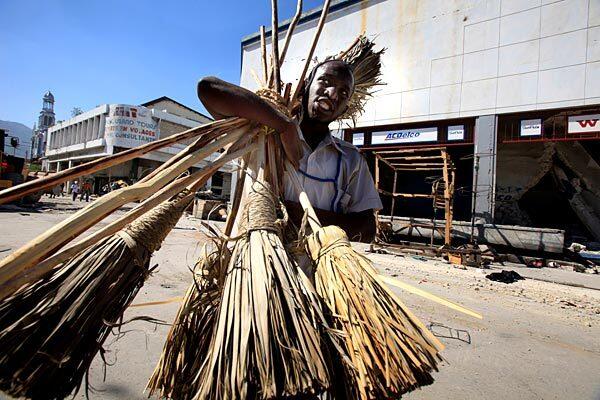
A teenager carries brooms for sale in downtown Port-au-Prince. (Brian Vander Brug / Los Angeles Times)
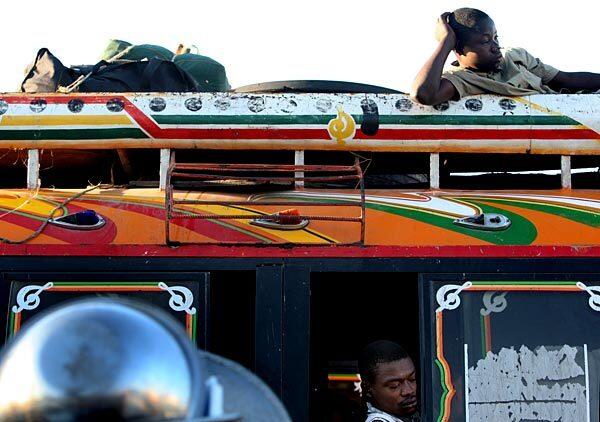
Passengers wait for a bus to leave Port-au-Prince. The government has asked anyone who can to leave the capital, offering free transportation to the less-affected provinces. (Brian Vander Brug / Los Angeles Times)
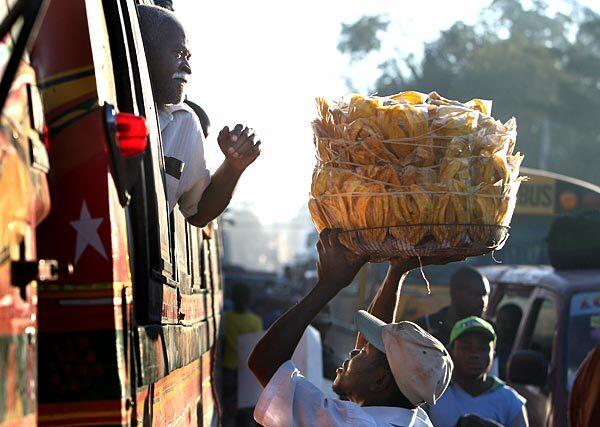
A vendor has snacks for sale to passengers waiting for their bus to head out of Port-au-Prince. (Brian Vander Brug / Los Angeles Times)
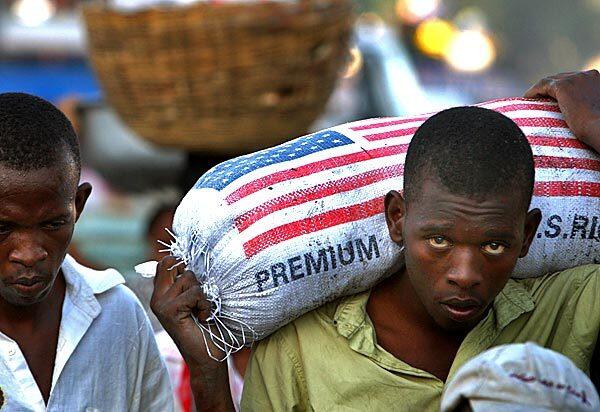
A man carries away a large bag of rice supplied by the United States. Many Port-au-Prince residents are complaining that they still have not received any aid. (Brian Vander Brug / Los Angeles Times)
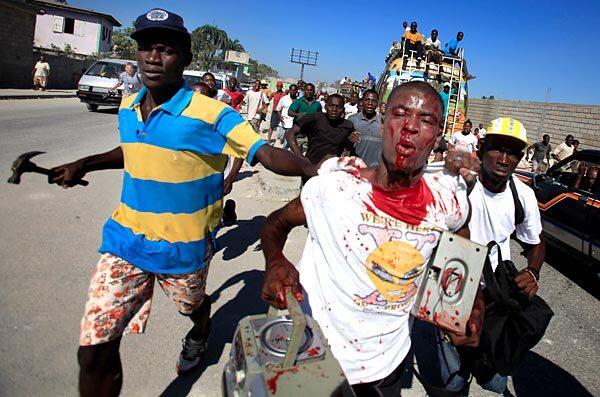
Michel Chedler, 28, is taken in by police after he was beaten during an argument over stolen property and chased by a mob chanting, “You stole! You stole!” in Port-au-Prince. The police planned to let him go after the crowd dispersed. (Brian Vander Brug / Los Angeles Times)
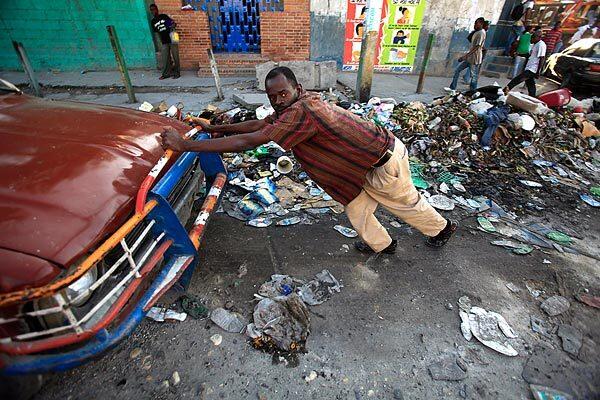
A man pushes a truck with an empty gas tank in Port-au-Prince. Gasoline is scarce. (Brian Vander Brug / Los Angeles Times)
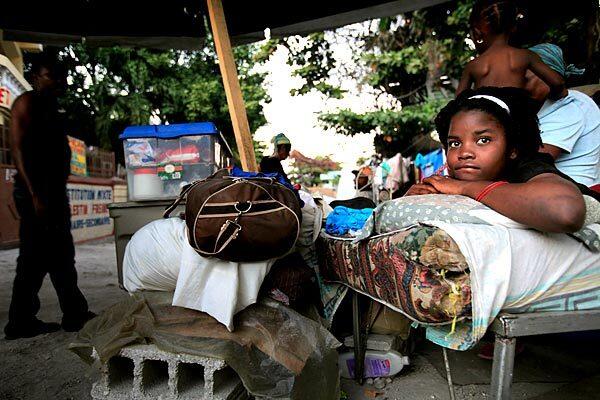
Joudelene St. Helaere, 14, lies on her bed in an alley at 36 Delmas Street, where she lives with 10 family members. Residents have organized a committee to find aid. (Brian Vander Brug / Los Angeles Times)
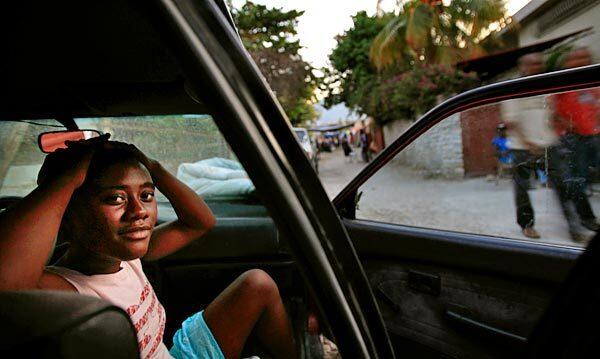
Widlene Petithomme, 16, lives with family members in a car in Port-au-Prince since the earthquake damaged their home. Residents of the Delmas 36 neighborhood are organizing to get aid. Most are living in the street. (Brian Vander Brug / Los Angeles Times)
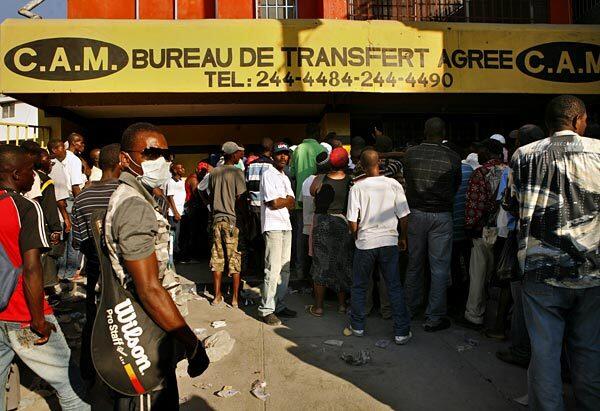
People line up at a money transfer office in Port-au-Prince, hoping to get money from relatives abroad. Many waited in line for hours without getting in before closing time. (Carolyn Cole / Los Angeles Times)
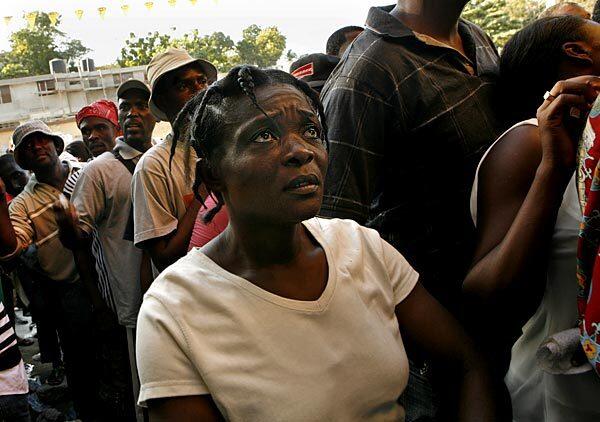
People wait in the heat at a Port-au-Prince money transfer office, hoping to get money from relatives abroad. (Carolyn Cole / Los Angeles Times)
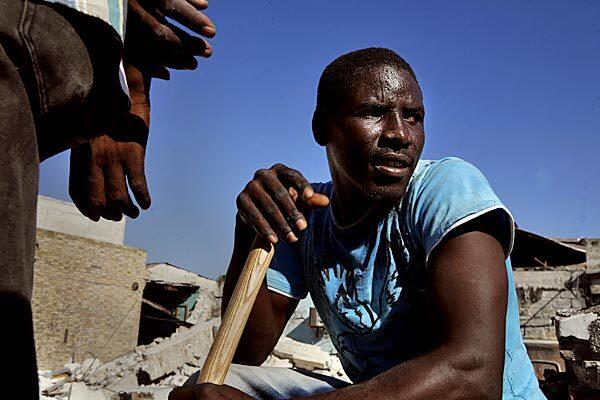
Sweat pours down the face of Marcel Otis, who has been using a sledge hammer to break up concrete in downtown Port-au-Prince. Merchants are hiring men to help get the remaining goods out of their damaged stores. (Carolyn Cole / Los Angeles Times)
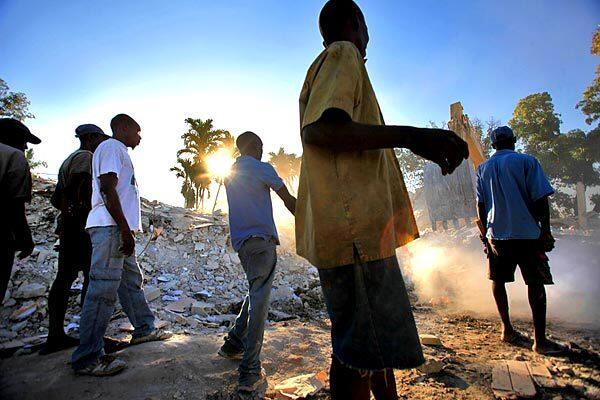
Scrap metal collectors wait for a backhoe to finish moving chunks of a fallen building before scrambling to salvage steel rebar in Port-au-Prince, the Haitian capital. Since the earthquake, salvage activity has exploded into all areas of the city instead of only the dump. (Brian Vander Brug / Los Angeles Times)
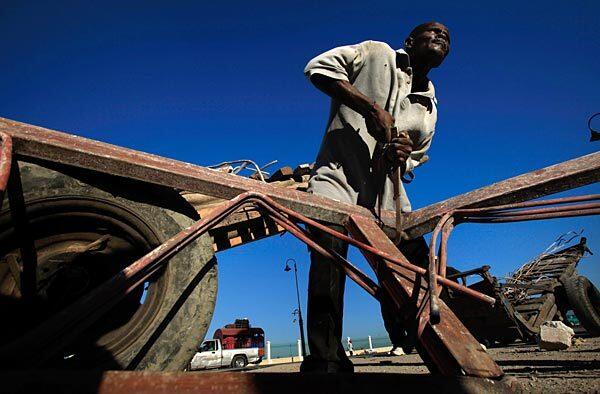
A scrap collector in Port-au-Prince tries sawing through metal. (Brian Vander Brug / Los Angeles Times)
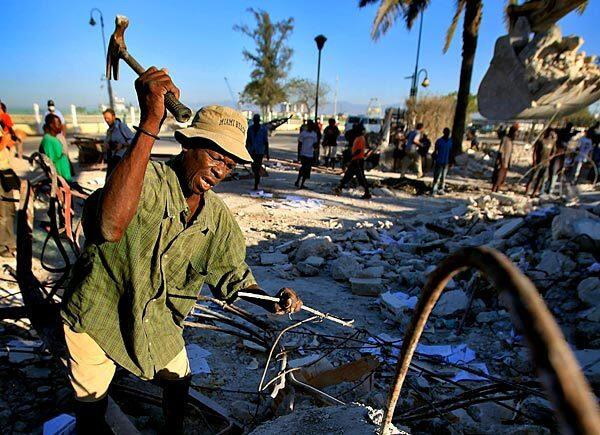
A scrap collector in Port-au-Prince hammers away concrete in the effort to get at rebar in the rubble. (Brian Vander Brug / Los Angeles Times)
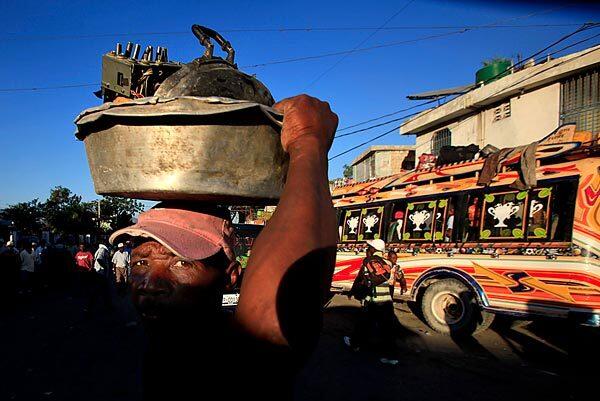
A scrap collector walks through a Port-au-Prince intersection carrying salvaged metal items on his head. (Brian Vander Brug / Los Angeles Times)
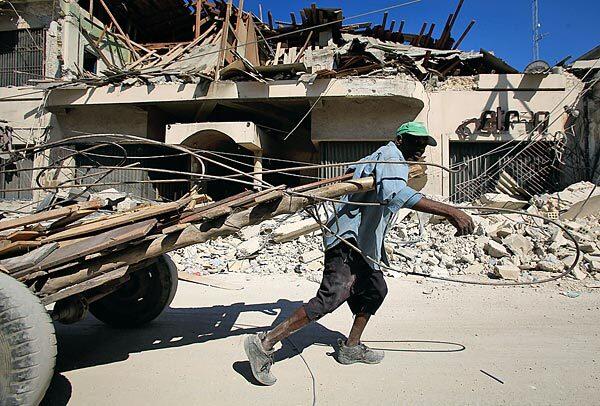
A scrap collector pulls a bwet, a wooden cart laden with wood he will use for cooking fuel, through the streets of downtown Port-au-Prince. (Brian Vander Brug / Los Angeles Times)
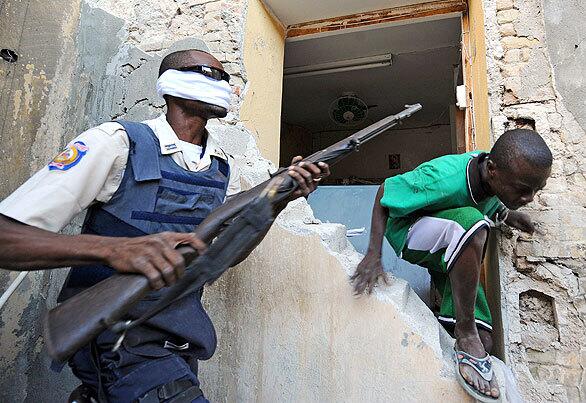
A Haitian policeman beats a young looter with his rifle in Port-au-Prince. (Jewel Samad / AFP / Getty Images)
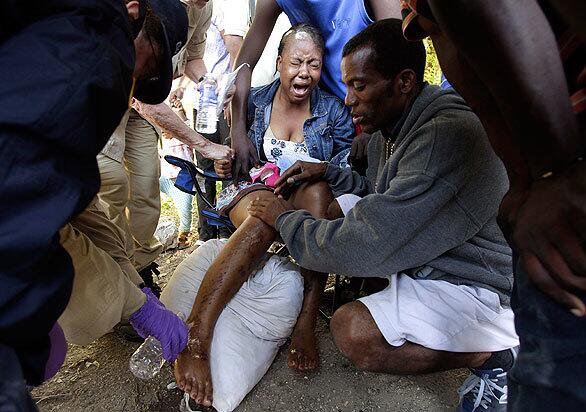
Melissa Dosou, 19, center, winces in pain as she is treated at a camp for the displaced in Port-au-Prince. (Jae C. Hong / Associated Press)
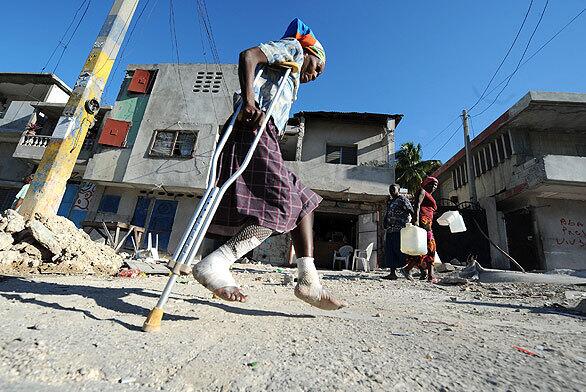
A woman on crutches heads toward an encampment in Port-au-Prince. (Jewel Samad / AFP / Getty Images)
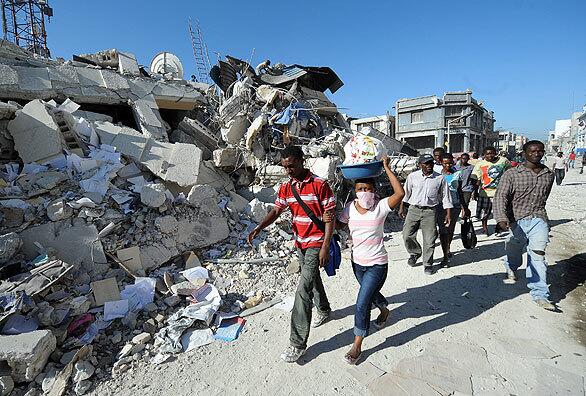
Collapsed buildings are a common sight in Port-au-Prince. (Jewel Samad / AFP / Getty Images)
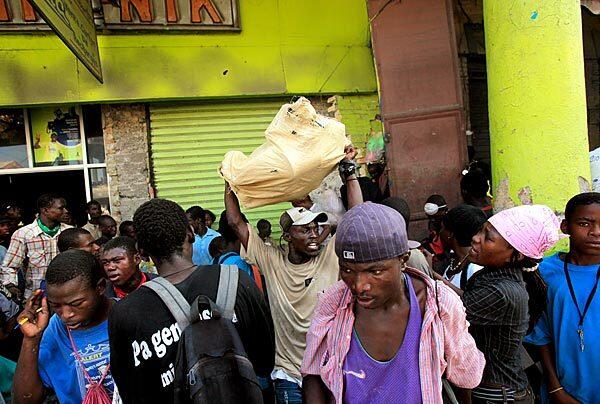
In what has become a daily ritual in downtown Port-au-Prince, looters carry goods out of stores, all while keeping an eye on nearby police. (Brian Vander Brug / Los Angeles Times)
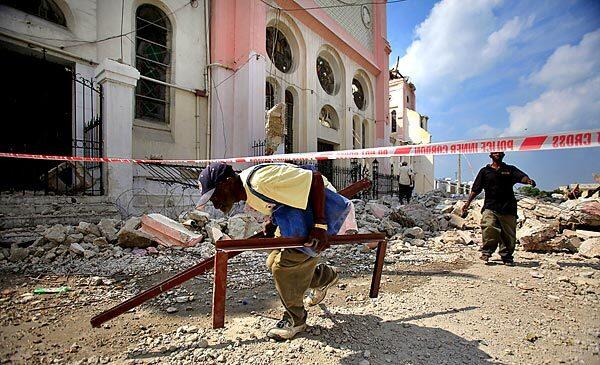
A man ducks under police tape warning passersby to avoid the ruins of the Notre Dame Cathedral of Port-au-Prince after a 5.9-magnitude aftershock shook the Haitian capital. (Brian Vander Brug / Los Angeles Times)
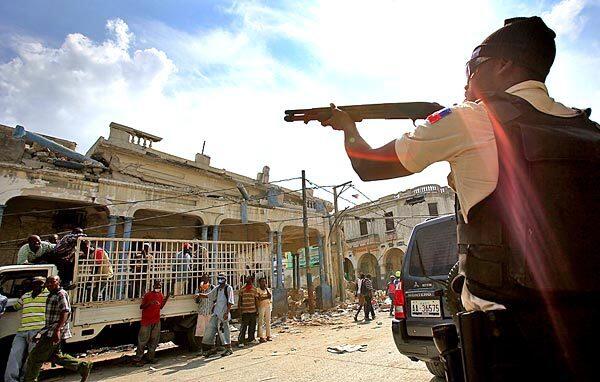
A policeman aims his shotgun toward looters in downtown Port-au-Prince, Haiti. (Brian Vander Brug / Los Angeles Times)
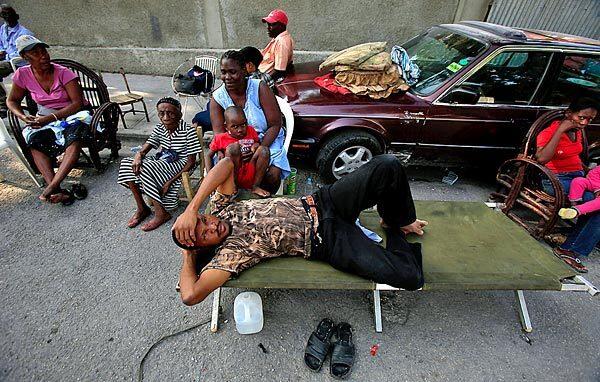
Haitian families take refuge in the streets in Port-au-Prince after a powerful aftershock. Thousands of earthquake survivors have stayed outdoors instead of indoors because their homes were ruined in the earthquake or they fear new temblors. (Brian Vander Brug / Los Angeles Times)
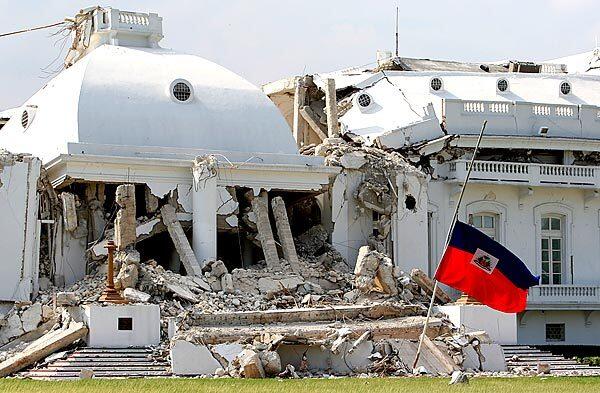
A Haitian flag flies at half-staff in front of the collapsed presidential palace in Port-au-Prince. The flag, which is usually raised everyday, was placed in front of the ruins seven days after the deadly earthquake. (Brian Vander Brug / Los Angeles Times)
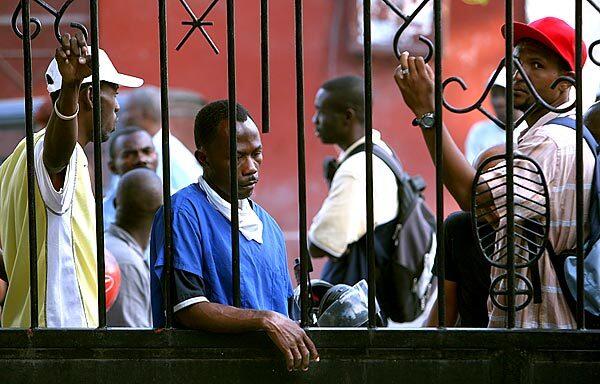
Haitian men wait for work from visiting journalists in front of the Oloffson Hotel in Port-au-Prince. (Brian Vander Brug / Los Angeles Times)
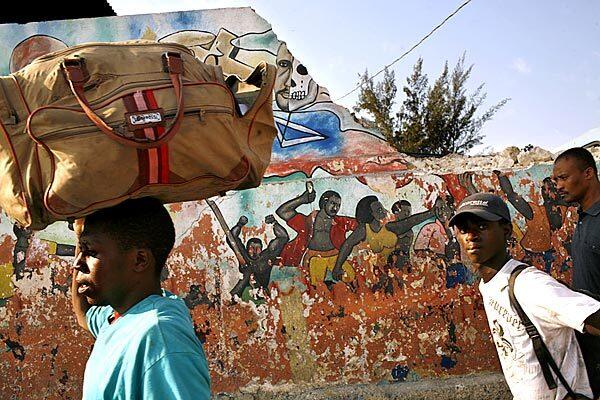
A damaged mural in Port-au-Prince displays artistic symbolism for death. (Carolyn Cole / Los Angeles Times)
Nov. 14, 2024